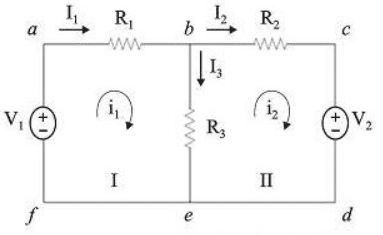This is a basic concepts post destined to students and beginners in the area. This is the first part about how to make circuit analysis in direct current only with resistors.
Kirchhoff’s laws
Before analyze circuits, it is necessary to how the Kirchhoff`s laws. The Kirchhoff`s law for voltages states that the algebraic sum of elevations and falls of voltages in a closed loop is zero. This law can be expressed in this form:
\sum V_{fontes}=\sum V_{cargas}
Or this form:
\sum V=0
The sum of voltages in a circuit loop will always be zero.






The Kirchhoff’s law to currents says that the algebraic sum of currents which enter and get out from a region, system or node is equal to zero. This law can be expressed in this form:
\sum I_{i}=\sum I_{o}
The total current which enters in a node is equal to total current which gets out from the same node.




Sources in series and parallel
Voltage sources with different values cannot stay parallel, only in series.

What happened if you put two sources of different values in parallel? Real sources have a small resistance in series, putting different values voltage source in parallel will produce a high current due to small resistance and the sources can be damaged. Do not put current sources of different values in series.

The reason is that real current sources have a high resistance in parallel, therefore put current sources of different values in series will generate a very high voltage and can damage the sources. Unless the sources have a protection system, which will stay to a future post.
Converting sources
The real sources, by that, with internal resistance, can be converted to ease the circuit analysis. The two sources below are equivalents.

The source conversion follows the Ohm’s law and the internal resistance value keep the same.
U=I\cdot R
Controlled sources
In circuit analysis, it is common to find controlled sources, which are sources dependent on voltage and current in some circuit’s part. In the schematics are represented like shows the figure below.

Delta-star connection
In addition to series and parallel, resistors can be positioned in star (Y) or delta (Δ) connections, also called T or π.


How to convert from a form to another? These three equations below are to convert from Δ to Y.
R_3=\frac{R_{A}R_{B}}{R_{A}+R_{B}+R_{C}}
R_1=\frac{R_{B}R_{C}}{R_{A}+R_{B}+R_{C}}
R_2=\frac{R_{A}R_{C}}{R_{A}+R_{B}+R_{C}}
And these three to convert from Y to Δ.
R_{C}=\frac{R_{1}R_{2}+R_{1}R_{3}+R_{2}R_{3}}{R_{3}}
R_{A}=\frac{R_{1}R_{2}+R_{1}R_{3}+R_{2}R_{3}}{R_{1}}
R_{B}=\frac{R_{1}R_{2}+R_{1}R_{3}+R_{2}R_{3}}{R_{2}}



